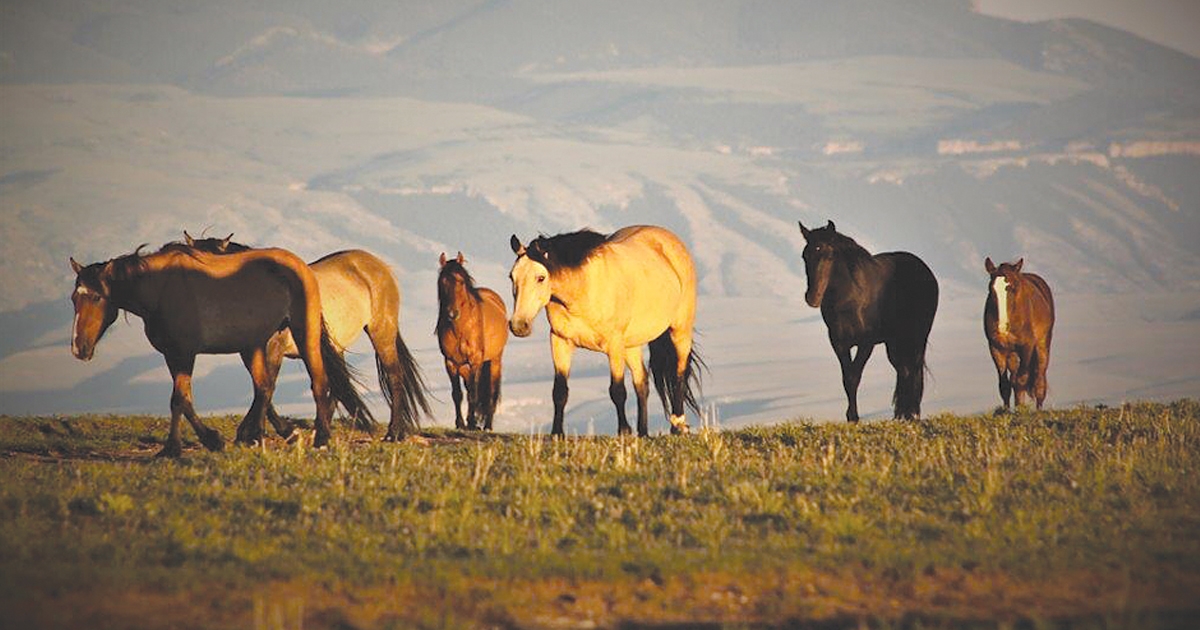People who want to escape the noise and stress of the present day may benefit from visiting the Pryor Mountain Mustangs. These horses hang out in the coolies and draws of the Pryor Mountains in Southeastern Montana, as their forbears have for centuries.
They aren’t your garden-variety horses. Their mystique comes in part from their ancient bloodline, which traces back to the first horses introduced to the Americas by the Spanish Conquistadors. They’re breathtaking to watch as they race wild and free through remote mountain meadows, or graze peacefully with their family group.
It’s not just their bloodlines, their amazing history, and their tough survival skills that make them special, according to Steve Cerroni.
Cerroni and his wife, Nancy, are owners of Pryorwild, which takes visitors into this remote area. They know the horses as well as anyone. They’ve seen the effect they have on people.
One guest asked if they could see a particular horse, Cloud, who had been featured in a PBS documentary. Ceronni couldn’t promise her they would find Cloud, but as it happened, she was the first horse they saw that day.
As the young woman watched and took photos, Steve noticed her tears. She explained that her dad gave her the Cloud video when she was 7 years old, and they watched it together two or three times a week. He had recently passed away.
“I told her, ‘Well, your dad just delivered Cloud to you again,’” he said.
Another time a trio of sisters came to spend the anniversary of their mother’s death with the mustangs, a favorite obsession of hers.
Cerroni also remembers a grandmother who kept calling to see if there was a cancellation because her granddaughter, who had to return to California, really wanted to see the horses.
Because the grandmother was so persistent, Steve finally agreed to take her granddaughter in his 4-wheeler, since the other two vehicles were full. When they got to the Pryor Mountain Wild Horse Range Visitor Center to pick up the guests, he learned that the 21-year-old had inoperable brain cancer and had only a few months to live.
“I was able to fulfill her dream to see the wild mustangs,” he said.
The horses had claimed this isolated spot on the Montana-Wyoming border at least a century before Congress set aside Pryor Mountain National Wild Horse Range in 1968. The parcel has since expanded to 38,000 acres. It is the first of three wild horse ranges in the nation.
Local folks celebrated its 50-year anniversary in 2018, knowing that without their persistence it wouldn’t have happened.
The Pryor Mountain Wild Horse Association continues to advocate for the horses today. It’s important to save the unique herd, because, if lost, it cannot be restored.
The group spearheaded the creation of the Pryor Mountain Wild Mustang Center in Lovell, where, each year, thousands of visitors learn the history and biology of these Spanish mustangs.
Extensive studies over the past five decades confirm that the animals are descendants of the Spanish mustang. This rare and endangered breed is shorter and stockier than domestic horses.
Their V-shaped face consists of a wide forehead tapering to a narrow muzzle, accented with large eyes and small ears. Other traits include their various colors and primitive striping, including a stripe down the back and zebra stripes on the legs and withers.
A database on each horse shows their DNA and tracks how the individuals are related. Studies show them to have a high genetic diversity, which means they have low levels of inbreeding.
The BLM keeps the numbers in line with what the range can support, which is around 140 animals.
Pryor Mountain wild horses that are removed and adopted bring an average of $1,700 in online bidding. Wild horses from other ranges usually go for the minimum bid of $125.
The last two Pryor Mountain mustangs went for more than $4,000.
Visitors and researchers alike are amazed at how the mustangs interact with each other. They work together as a family to survive in this high, harsh terrain.
The fact that they have survived for so long with little human interference is evidence of their intelligence.
Today they aren’t bothered by vehicles or people, so individuals can get good photos without having a long lens. Even though the horses are surprisingly docile, the BLM asks that people stay 100 feet away and not harass them.
The history of the Pryor Mountain herd can’t be nailed down. There are accounts of wild horses in this area in the late 1800’s but many believe that they were brought to the area by Native People, most likely the Crow, in the 1700s.
Cerroni said however well the horses survived on their own, continued good management is key to their survival into the future. He doubts people will abandon them.
“I believe that this herd is so unique and so important that people will stand behind them and continue the careful management done by the BLM today,” he said.
Around 4,000 people came to the visitor center last year, hailing from all 50 states and 34 foreign countries.
The center is just east of Lovell and east of the Cal S. Taggart Bighorn Canyon National Recreation Area Visitor Center on Highway 14A.
Some of the wild horses may be found along this paved highway, which borders the Big Horn Canyon National Recreation Area. The majority of the mustangs are farther into the range.
The one road that goes to the top of the mountain is a rugged trail, requiring a high-clearance, four-wheel drive vehicle to access it.
The cost for the all-day trip is $195 per person, and includes meals, snacks, and water. They take no more than six people at a time.
“I’m telling you, those horses are amazing,” said Cerroni. MSN
Readers may visit their website, pryorwild.com to learn more, or email them at [email protected]. To contact the Pryor Mountain Wild Horse Range Visitor Center, call 307-548-9453.










